 |
PO Box 9021,
Wilmington, DE 19809, USA
E-mail: font@focusonnature.com
Phone: Toll-free in USA 1-888-721-3555
or 302/529-1876 |
MAMMALS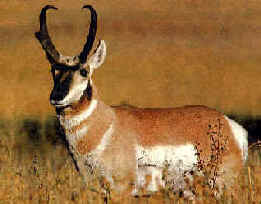
in
Texas
noting those
during Focus On Nature Tours
with an (*)
1991 thru 2014
A List of Mammals in Texas
compiled by Armas Hill
Photo at right: PRONGHORN
Code:
(ph): species with a photo in the FONT web-site
Links:
Upcoming
FONT Birding & Nature Tours in Texas
A List & Photo Gallery of Texas Birds, in 2 parts:
Part #1: Quails to Becard
Part #2: Flycatchers to Buntings
A
List of Texas Butterflies (with some photos)
A List of Texas Dragonflies & Damselflies
(with some
photos)
A List of Texas Amphibians & Reptiles
(with some
photos)
Plants
of the Desert & some nearby habitats (with
some photos)
Directory of Photos in this
Website

List of Mammals:
AMERICAN OPOSSUMS, in the Order
Didelphimorphia (formerly Marsupialia),
Family Didelphidae
(78 species in the New World)
- Virginia Opossum (*) ______
Didelphis virginiana
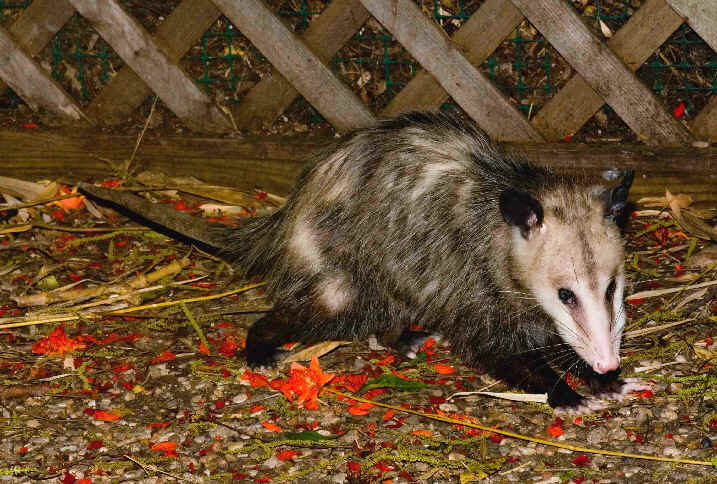
A Virginia Opossum during
the FONT tour in Texas in 2010
(photo by Karl
Frafjord)
ARMADILLOS,
in the Superorder
Xenarthra
(formerly
Edentata) (now in the
Order Cingulata)
("Edentates" means "those without teeth". However, this term is more
appropriate for the xenarthrans that truly are toothless,
the Old
World pangolins.)
Family Dasypodidae (21 species in the New World)
Nine-banded (Long-nosed) Armadillo (*) (ph)
______
Dasypus novemcinctus
Dasypus novemcinctus is the only armadillo that inhabits the
United States.
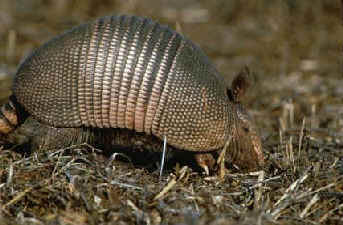
Nine-banded Armadillo
RABBITS & HARES,
in
the Order Lagomorpha, Family Leporidae
(57 species worldwide)
Desert Cottontail (*) (ph) ______
Sylvilagus audubonii
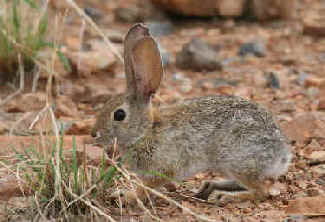
Desert Cottontail
Eastern Cottontail (*) (ph) ______
Sylvilagus floridanus
Swamp Rabbit ______
Sylvilagus aquaticus
Black-tailed Jackrabbit (*) (ph) ______
Lepus californicus
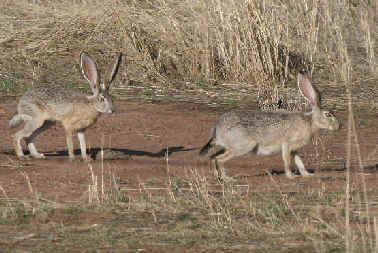
Black-tailed Jackrabbits
RODENTS: gnawing mammals (Order Rodentia - the largest order of mammals with nearly 2,000
species worldwide)
Families include:
Squirrels (Sciuridae)
Beavers (Castoridae)
Pocket Gophers (Geomyidae), including Pocket Mice & Kangaroo Rats
Mice & Rats (Muridae), New World Mice & Rats (subfamily
Sigmodontinae)
New World Porcupines (Erethizontidae)
SQUIRRELS, in the Family Sciuridae (276 species worldwide)
Blacktail Prairie Dog ______
Cynomys ludovicianus
Texas Antelope Squirrel (*) ______
Ammospermophilus interpres
Thirteen-lined Ground Squirrel ______
Spermophilus tridecemlineatus
Mexican Ground Squirrel (*) ______
Spermophilus mexicanus
Spotted Ground Squirrel ______
Spermophilus spilosoma
Rock Squirrel (*) (ph) ______
Spermophilus variegatus
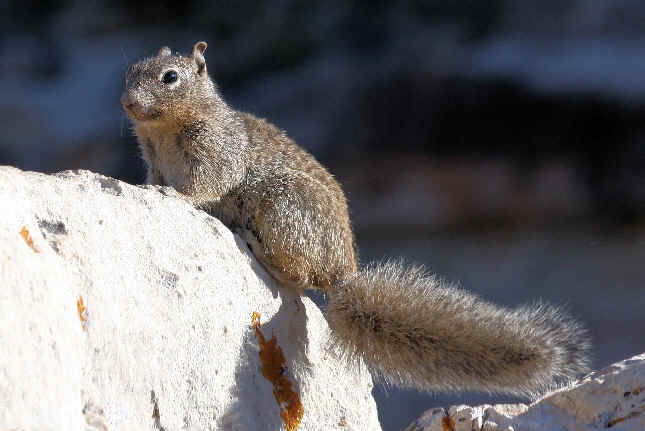
Rock Squirrel
Gray-footed Chipmunk ______
Tamias canipes
Eastern Gray Squirrel (ph) ______
Sciurus carolinensis
Eastern Fox Squirrel (*) (ph) ______
Sciurus niger
Southern Flying Squirrel ______
Glaucomys volans
POCKET GOPHERS, in the Family Geomyidae (99 species in North America)
includes Pocket Mice & Kangaroo Rats
Botta's Pocket Gopher ______
Thomomys bottae
Yellow-faced Pocket Gopher (*) ______
Cratogeomys castanops
Baird's Pocket Gopher ______
Geomys breviceps
Attwater's Pocket Gopher ______
Geomys attwateri
Knox Jones's Pocket Gopher ______
Geomys knoxjonesi
Central Texas Pocket Gopher ______
Geomys texensis
Plains Pocket Gopher ______
Geomys bursarius
Texas Pocket Gopher ______
Geomys personatus
Desert Pocket Gopher ______
Geomys arenarius
Plains Pocket Mouse
______
Perognathus flavescens
Merriam's Pocket Mouse ______
Perognathus merriami
Silky Pocket Mouse ______
Perognathus flavus
Nelson's Pocket Mouse ______
Chaetodipus nelsoni
Rock Pocket Mouse ______
Chaetodipus intermedius
Mexican Spiny Pocket Mouse ______
Liomys irroratus
Hispid Pocket Mouse ______
Chaetodipus hispidus
Chihuahan Pocket Mouse (*) ______
Chaetodipus eremicus
Kangaroo Rats have enormous hind feet, miniature front feet, and long
tails.
Merriam's Kangaroo Rat ______
Dipodomys merriami
Banner-tailed Kangaroo Rat ______
Dipodomys spectabilis
Texas Kangaroo Rat ______
Dipodomys elator
Ord's Kangaroo Rat ______
Dipodomys ordii
Gulf Coast Kangaroo Rat ______
Dipodomys compactus
TRUE MICE & RATS,
including also Voles & Gerbils, in the Family Muridae (1,394
species worldwide)
Eastern Woodrat ______
Neotoma floridana
Mexican Woodrat ______
Neotoma mexicana
Southern Plains Woodrat ______
Neotoma micropus
White-throated Woodrat
______
Neotoma albigula
House Rat ______ (introduced from Europe
with the earliest colonists)
Rattus rattus
Brown Rat ______ (also called Common Rat,
or, incorrectly, Norway Rat) (introduced worldwide with human settlements,
originally from southeast Siberia & northern China)
Rattus norvegicus
Northern Grasshopper Mouse ______
Onychomys leucogaster
Southern Grasshopper Mouse ______
Onychomys torridus
Chihuahuan Grasshopper Mouse ______
Onychomys arenicola
Rice Rats are nocturnal, mostly aquatic rats that are diverse in the
Neotropics, where there are more 35 species. 2 species reach the US.
Coue's Rice Rat ______
Oryzomys couesi
Marsh Rice Rat ______
Oryzomys palustris
Northern Pygmy Mouse ______
Baiomys taylori
Fulvous Harvest Mouse ______
Reithrodontomys fulvescens
Eastern Harvest Mouse ______
Reithrodontomys humulis
Plains Harvest Mouse ______
Reithrodontomys montanus
Western Harvest Mouse ______
Reithrodontomys megalotis
House Mouse ______ (a cosmopolitan,
introduced species, most common around human habitations)
Mus musculus
White-footed Deermouse ______
Peromyscus leucopus
North American Deermouse ______
Peromyscus maniculatus
Cotton Deermouse ______
Peromyscus gossypinus
Cactus Deermouse ______
Peromyscus eremicus
Pinon Deermouse ______
Peromyscus truei
Northern Rock Deermouse ______
Peromyscus nasutus
Texas Deermouse ______
Peromyscus attwateri
Brush Deermouse ______
Peromyscus boylii
White-ankled Deermouse ______
Peromyscus pectoralis
Golden Mouse ______
Ochrotomys nuttalli
Hispid Cotton Rat (*) ______
Sigmodon hispidus
Yellow-nosed Cotton Rat ______
Sigmodon ochrognathus
Voles (& Lemmings) in the Subfamily
Arvicolinae (140 species worldwide)
Woodland Vole ______
Microtus pinetorum
AQUATIC MAMMALS
The
Muskrat in the same subfamily,
Arvicolinae, as Voles & Lemmings, in
the
Order Rodentia.
The
American Beaver is 1 of 2 species in the
Family Castoridae, Order
Rodentia. The other species is in Eurasia.
The introduced
Nutria, from South America, is in the
Family Echimyidae, of
Spiny Rats, indigenous to that continent -
in
that family, 81 species in
South America.
Muskrat (ph) ______
Ondatra zibethicus
American Beaver (ph) ______
Castor canadensis
Nutria (*) (ph) ______ (also called
Coypu) (introduced,
native to South America)
Myocastor coypus
NEW WORLD PORCUPINES (Family Erethizontidae) (17 species in the New
World)
North American Porcupine (*) (ph) ______
Erethizon dorsatum
Erethizon dorsatum is the only porcupine in North America.
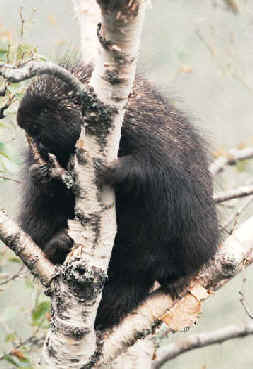
North American Porcupine
CARNIVORES (Order Carnivora)
Families include:
Canines: Dogs & Foxes (Canidae)
Felines: Cats (Felidae)
Bears: (Ursidae)
Procyonids: Raccoons & allies (Procyonidae)
Mustelids: Weasels, Skunks & allies (Mustelidae)
CANINES, Dogs & Foxes, in the Family Canidae (35 species worldwide)
Coyote (*) (ph) ______
Canis latrans
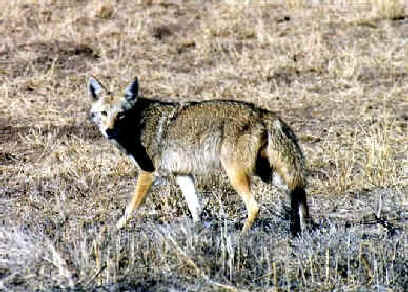
Coyote
The Red Wolf,
Canis rufus, formerly occurred in the wild in Texas. Some
say that this was a hybrid between the Coyote and the now more-northerly
Gray Wolf.
Gray Fox (*) ______
Urocyon cinereoargenteus
Red Fox (ph) _____
Vulpes fulva
(the North
American animal considered by some as conspecific with the Old World
Red Fox, Vulpes
vulpes)
Swift Fox ______
Vulpes velox
Kit Fox (*) ______
Vulpes macrotis
FELINES, Cats, in the Family Felidae (39 species worldwide)
Bobcat (*) (ph) ______
Lynx rufus
Puma (ph) ______
(also called
Cougar or Mountain
Lion)
Puma concolor
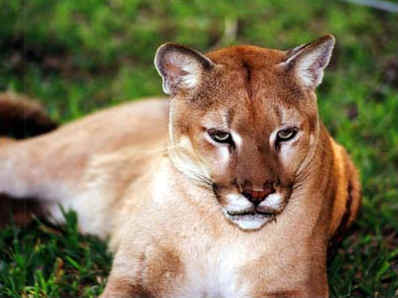
Puma
Jaguarundi ______
(endangered in the US due to limited range)
Puma yagouaroundi
Margay ______ (probably
never common in Texas, the last record there was in 1852.)
Leopardus wiedii
Ocelot (ph) ______ (rare,
endangered in Texas)
Leopardus pardalis
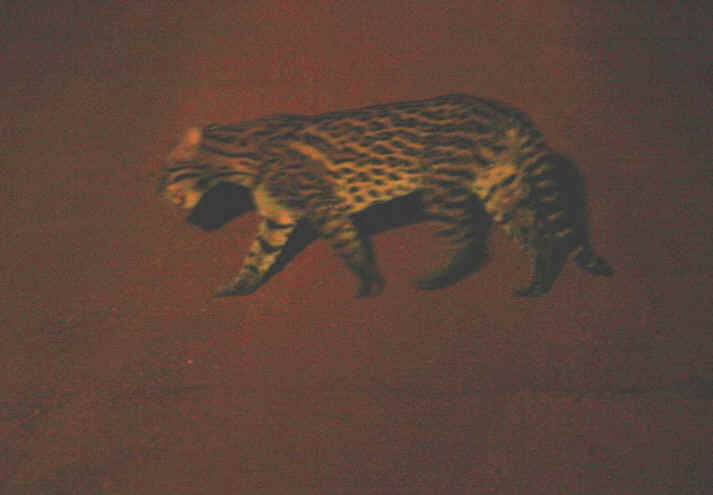
Ocelot
BEARS, in the Family Ursidae (8 species worldwide)
American Black Bear ______
Urus (formerly Euarctos) americanus
PROCYONIDS, Raccoons & allies, in the Family Procyonidae (19 species, all in
the Americas, except 1, the Red Panda of Asia)
Northern Raccoon (*) (ph) ______
Procyon lotor
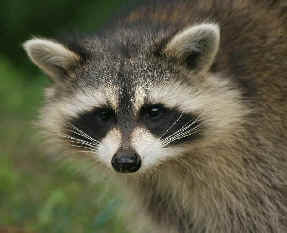
Northern Raccoon
Ringtail (*) ______
Bassariscus astutus
White-nosed Coati (ph) ______
Nasua narica
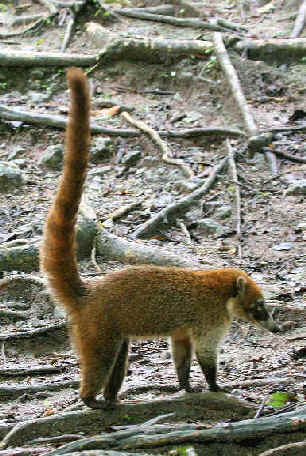
White-nosed Coati
MUSTELIDS,
including Otters, Weasels, Skunks, Badger, in the Family
Mustelidae (68
species worldwide)
Northern River Otter ______
Lontra canadensis
American Badger (ph) ______
Taxidea taxus
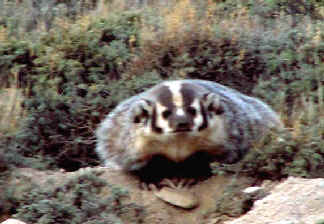
American Badger
Long-tailed Weasel
______
Mustela frenata
Black-footed Ferret ______
Mustela nigripes
The Black-footed Ferret is now extinct in the wild. It formerly
occurred commonly in Texas.
Western Spotted Skunk
______
Spilogale gracilis
Eastern Spotted Skunk (*) ______
Spilogale putorius
Eastern Hog-nosed Skunk ______
Conepatus leuconotus
Western Hog-nosed Skunk ______
Conepatus mesoleucus
Hooded Skunk ______
Mephitis macroura
Striped Skunk (*) (ph) ______
Mephitis mephitis
SHREWS & MOLES,
now in the Order Erinaceomorpha,
formerly Insectivores
"insect eaters" - this
group,
throughout
much of the world, includes shrews, moles, hedgehogs,
moonrats, and tenrecs.)
SHREWS, in the Order Soricodae, Family Soricidae (335 species worldwide)
Least
Shrew ______
Cryptotis parva
Desert Shrew ______
Notiosorex crawsfordi
MOLES, along with SHREW-MOLES, and DESMANS, in the Family Talpidae
(42
species worldwide)
Eastern Mole ______
Scalopus aquaticus
BATS, in the Order Chiroptera - with about 950 species worldwide, the
diversity of bats is second only to that of rodents
There are 32 species of bats living
in Texas today. 4 others are known from fossil skeletal remains.
One of those
four, Myotis rectidentis, is extinct.
The other three - Myotis evotis,
Macrotus californicus, and Desmodus rotundus - still occur in
other parts of
North America.
Macrotus californicus, the Leaf-nosed Bat, occurs in southern Arizona, Nevada,
and California southward into Mexico.
Desmodus rotundus, the Common Vampire Bat, occurs in Mexico, and has been
found recently about 200 kilometers south of the Texas border near in
Tamaulipas.
Searching may reveal the presence of both of these, the Macrotus &
Desmodus, in Texas.
Leaf-chinned Bats, in the Family Mormoopidae (8 species in the New World)
(Peter's) Ghost-faced
Bat ______
Mormoops megalophylla
Mormoops megalophylla occurs in riparian zones in arid lands.
American Leaf-nosed Bats, in the Family Phyllostomidae (155 species in the New
World)
Mexican Long-nosed Bat ______
Leptonycteris nivalis (formerly conspecific with the North
American Long-nosed Bat, L. yerbabuenae)
Leptonycteris nivalis is an endangered species.
Mexican Long-tongued Bat (ph) ______
Choeronycteris mexicana
Choeronycteris mexicana forms small colonies in caves, mine tunnels, buildings, and
culverts.
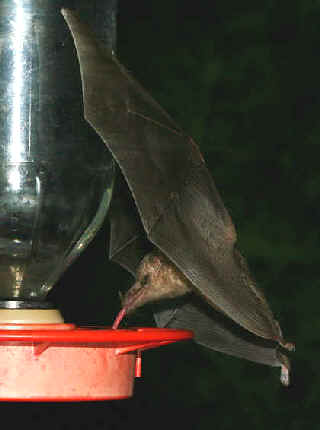
A Mexican Long-tongued Bat visiting a hummingbird
feeder at night.
Hairy-legged Vampire Bat ______
(in the US,
known only from a single specimen in Val Verde County, Texas)
Diphylla ecaudata
Free-tailed Bats, in the Family Molossidae (94 species worldwide)
Mexican (or Brazilian) Free-tailed Bat (*)
(ph) ______
Tadarida brasiliensis
Tadarida brasiliensis forms summer nursery colonies composed of millions in
large caves.
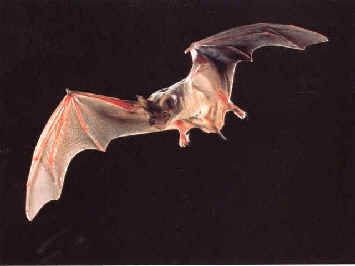
Above & Below: Mexican Free-tailed Bats
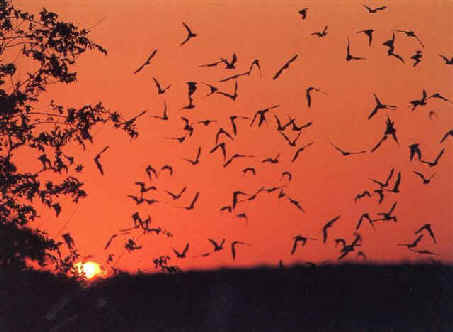
The following relates to Mexican Free-tailed Bats at a cave in Mason
County, Texas:
"About 4 million female bats inhabit the cave from May through September.
Many of them are pregnant when they arrive from Mexico. They give birth to a
single offspring in June or July. The young bats grow rapidly and are able to
fly at about 5 weeks of age, They remain, however, with their mothers until they
return to Mexico in October.
About an hour or two before sunset, hundreds of bats flutter and chirp around
the mouth of the cave. Slowly, a stream of bats emerges and flies in a large
circle, low to the ground, just outside the cave entrance. These bats gradually
spiral upwards and form a dark funnel of flying mammals, reaching several
hundred feet into the evening sky. The bats at the top of the spiral break off,
forming columns that stream out over the countryside. The incredible torrent of
bats forms a densely packed "bat tornado" for about an
hour."
Pocketed Free-tailed Bat ______
Nyctinomops femorosaccus
Nyctinomops femorosaccus occurs near large open-water sources, where it feeds in the
evening.
Big Free-tailed Bat (*) ______
Nyctinomops macrotis
Nyctinomops macrotis
lives in rugged, rocky canyon country.
Greater Bonneted Bat ______ (also
called Western Mastiff Bat)
Eumops perotis
Eumops perotis
lives in crevices in vertical cliffs in rugged canyonlands.
Vesper Bats, in the
Family Vespertilionidae (364 species worldwide)
Spotted Bat ______
Euderma maculatum
Euderma maculatum is widespread but rarely seen. It lives in mountain and basin
country.
Silver-haired Bat (ph) ______
Lasionycteris noctivagans
Eastern Red Bat (ph) ______
Lasiurus borealis
The Eastern Red Bat & Western Red Bat have
recently been split.
Western Red Bat ______
Lasiurus blossevillii
Seminole Bat ______ (in TX, in the east
& south)
Lasiurus seminolus
Lasiurus seminolus favors Spanish Moss as a day roost.
Northern Yellow Bat ______
Lasiurus intermedius
Southern Yellow Bat ______
Lasiurus ega
Hoary Bat ______
Lasiurus cinereus
Rafinesque's Big-eared Bat ______
Corynorhinus rafinesquii
Corynorhinus rafinesquii forms small colonies in a variety of places: man-made structures, caves,
hollow trees, and even under loose tree bark.
Townsend's Big-eared Bat ______
Corynorhinus townsendii
Corynorhinus townsendii often hunts in edge habitats, between forest and open
areas.
Allen's Big-eared Bat ______
Idionycteris phyllotis
Idionycteris phyllotis occurs in a variety of arid and wooded
habitats.
Pallid Bat ______
Antrozous pallidus
Antrozous pallidus occurs in a variety of arid and semi-arid
habitats. Its unique foraging style
allows it to pick up prey, such as scorpions, from the surface of the
ground.
Fringed Myotis ______ (in TX, in the
far-west)
Myotis thysanides
Myotis thysanides occurs in desert, grassland, and woodland
habitats.
California Myotis ______ (in TX, in
far-west)
Myotis californicus
Myotis califonricus occurs in deserts and in interior mountain
basins.
Western Small-footed Myotis ______ (in TX,
in far-west)
Myotis ciliolabrum
Myotis ciliolabrum occurs in rocky outcrops in short grass
habitats.
Long-legged Myotis ______ (in TX, in
far-west)
Myotis volans
Myotis volans lives in coniferous forests, and in oak and riparian woodlands, extending into
the desert.
Cave Myotis ______
Myotis velifor
Myotis velifor forms large colonies in caves.
Little Brown Myotis ______
Myotis lucifugus
Yuma Myotis (*) ______
Myotis yumanensis
Myotis yumanensis is common in deserts, but not far from a water
source.
Southeastern Myotis ______ (in TX, only in
northeast part of the state)
Myotis austroriparius
Northern Myotis ______
Myotis septentrionalis
Big Brown Bat ______
Eptesicus fuscus
Eptesicus fuscus frequently roosts in man-made structures and occurs in a wide variety of
habitats.
Evening Bat (*) ______ (in TX, in the east
& south)
Nycticeius humeralis
Eastern Pipistrelle ______ (in east TX)
Pipistrellus subflavus
Western Pipistrelle (*) ______ (in west
TX)
Pipistrellus hesperus
EVEN-TOED UNGULATES, in the
Order Artiodactyla
This order worldwide is diverse, including: pigs, hippopotamuses, camels,
deer, antelope, and cattle.
SHEEP, GOATS, & OLD WORLD ANTELOPES,
in the
Family Bovidae, along with
cattle, buffalo, and others.
(141
species worldwide)
Bighorn Sheep (ph) ______
Ovis canadensis
Barbary Sheep (or Aoudad) ______
(introduced in the Panhandle region of Texas, native to northern
Africa)
Ammotragus lervia
Blackbuck ______ (introduced widely
in Texas, in more than 51 counties, with the most on the Edwards Plateau.
Native to India & Pakistan.)
Antilope cervicapra
Nilgai ______ (a large exotic
antelope, introduced and now wild in southern Texas, especially in Kennedy
and Willacy Counties. Native to India, Pakistan, & Nepal.)
Boselaphus tragocamelus
PRONGHORN ANTELOPE, in the
Family Antilocapridae)
There is only one living species in this exclusively American family.
Pronghorn (*) (ph) ______ (IN PHOTOGRAPH AT
TOP OF LIST)
Antilocapra americana
The Pronghorn is the fastest North American mammal. It has been clocked at 60
mph.
NEW WORLD PIGS OR PECCARIES -
2 species, 1 of which
north of Mexico, in the Family Tayassuidae
Note: the Old World Swine (Boars, introduced various places in North
America) are in the Family Suidae.
Collared Peccary (*) (ph) ______ (also
called Javelina)
Pecari tajacu (formerly Pecari angulatus)
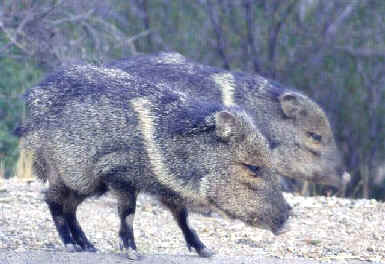
Collared Peccaries
DEER, in the
Family Cervidae:
hoofed animals with antlers shed each year (47
species worldwide)
(American) Elk (or Wapiti) (ph)
______
Cervus elaphus canadensis
(another, slightly smaller, subspecies in Europe
is called there the Red Deer)
Mule Deer (*) (ph) ______
Odocoileus hemionus
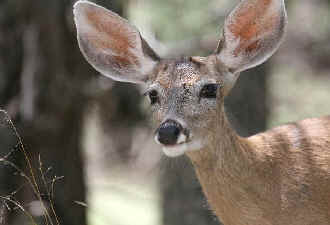
Mule Deer
White-tailed Deer (*) (ph) ______
Odocoileus virginianus
Among the subspecies is the "Sierra del Carmen White-tailed Deer"
in the Chisos Mountains of west Texas.
The White-tailed Deer occurs in all 48 states of the lower mainland US.
EXOTIC UNGULATES
Chital
(or Axis Deer) ______
(This spotted deer is now the most abundant exotic ungulate in
Texas. It is native to India and some surrounding countries.)
Axis axis
Sambar ______
(A small
number now established in Texas. It is native to India and Southeast Asia.)
MARINE MAMMALS II - PORPOISES, DOLPHINS, & WHALES, in the Order Cetacea
All of the following, either along the Gulf Coast, or further offshore in
the Gulf of Mexico.
TOOTHED WHALES, in the Suborder Odontoceti) including
Dolphins & Porpoises, Beaked Whales & Sperm Whale.
OCEAN DOLPHINS, in the Family Delphinidae (34 species worldwide)
Common Bottle-nosed Dolphin (ph) ______
Tursiops truncatus
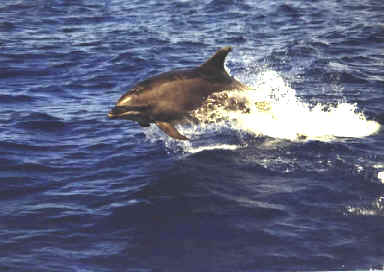
Common Bottle-nosed Dolphin
Atlantic Spotted Dolphin ______
Stenella frontalis
Pantropical Spotted Dolphin ______
Stenella attenuata
Spinner Dolphin ______
Stenella longirostris
Clymene (or Short-snouted
Spinner) Dolphin (ph) ______
Stenella clymene
Striped Dolphin ______
Stenella coeruleoalba
Rough-toothed Dolphin _______
Steno bredanensis
Pygmy Killer Whale ______
Feresa attenuata
False Killer Whale ______
Pseudorca crassidens
Melon-headed Whale ______
Peponocephala electra
Short-finned Pilot Whale ______
(has also been
called "Blackfish")
Globicephala macrorhynchus
Males of the
Short-finned Pilot Whale grow to up to over 22 feet in length; females
up to over 16 feet long. Males weigh to to 2,640 pounds; females up to 1,760
pounds.
BEAKED WHALES, in the Family Ziphiidae (21 species worldwide)
Pelagic in habitat, most are poorly known.
Cuvier's Beaked Whale (ph) ______ (has also been called Goosebeak Whale)
Ziphius cavirostris
Blainville's Beaked Whale ______
Mesoplodon densirostris
GREAT SPERM WHALE, in the
Family Physeteridae (1 species worldwide)
2 smaller species, the Pygmy Sperm Whale and the Dwarf Sperm Whale, are now
placed in a different family,
KOGIIDAE. They appear to be
distantly related to the
Great Sperm Whale.
Great Sperm Whale (ph) ______ (has also been called Cachalot)
Physeter catodon
BALEEN WHALES
- whales without teeth, in the Suborder Mysticeti
RORQUAL (or FINBACK) WHALES, in the Family Balaenopteridae
(8 species worldwide)
Bryde's Whale ______
Balaenoptera edeni
Sei Whale ______
Balaenoptera borealis
Fin Whale (ph) ______ (has also been called Common Rorqual)
Balaenoptera physalus
References for the above mammal-list include:
"Mammals of North America" by Roland W. Kays & Don E. Wilson,
published by Princeton Univ Press, 2002.
"Mammals of the World - A Checklist", by Andrew Duff &
Ann Lawson, 2004
"A Field Guide to the Mammals (of North America north of Mexico), by
William H. Burt & Richard P. Grossenheider
"Eyewitness Handbook: Whales, Dolphins & Porpoises - a Visual Guide to
the World's Cetaceans", by Mark Carwardine, illustrated by Martin Camm,
1995
"World Guide to Mammals" by Nicole Duplaix
& Noel Simon, 1976
"The Encyclopedia of Mammals", edited by Dr. David Macdonald, 1984
"A Field Guide to the Mammals of Central America & Southeast
Mexico", by Fiona A. Reid, 1997




















